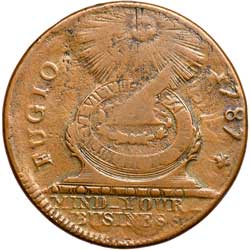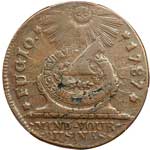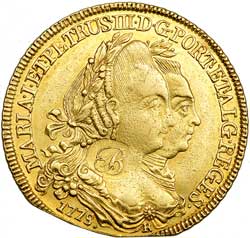
|
Vente N° 75
| Lot |
Photo |
Description |
Prix atteint |
Lot 58 |
 |
1787 Fugio Cent Newman 1-B Rarity-4 Cross After Date variety F12. A UNITED STATES reverse variety. Slightly sharper but lightly cleaned and nicely retoned glossy medium brown and light olive. Mostly smooth but there are traces of minor pitting on both sides. Struck slightly off center to K-3 but the date and legends remain on the planchet and are clear. The Cross following the date is strong. LDS showing doubled clashmarks at the top of the reverse. Weight 134.7 grains. Listed on page 87 in the "Redbook." Estimated Value $500-UP
From the Vincent W. Alones collection.
Voir détails et photos agrandies
| Prix atteint
$661 |
Lot 59 |
 |
1787 Fugio Cent Newman 3-D Rarity-3 Club Rays type VG10. At least 5 points sharper but covered with fine to moderate granularity under rather glossy chocolate and steel brown toning. There are a few specks of verdigris on both sides, none notable, but no contact marks or planchet flaws. The date is strong and the legends are clear except for UNITED STATES on the label, which is faint. Weight 155.7 grains. Listed on page 88 in the "Redbook." Estimated Value $250-UP
Ex Stack's Americana Sale, 1/24/2012:7758 (lot ticket included).
Voir détails et photos agrandies
| Prix atteint
$259 |
Lot 60 |
 |
1787 Fugio Cent Newman 14-O Rarity-4 F15. A STATES UNITED variety. Sharpness VF25 or slightly better but covered with microscopic granularity that is visible only under magnification. There are specks of greenish verdigris on the reverse and some faint hairline scratches on the obverse, all well hidden in the natural toning. Slightly glossy chocolate brown. The date and legends are complete and clear. Weight 159.7 grains. Listed on page 87 in the "Redbook." Estimated Value $350-UP
Voir détails et photos agrandies
| Prix atteint
$443 |
Lot 61 |
 |
1787 Fugio Cent Newman 17-S Rarity-3 PCGS graded VF30. A STATES UNITED variety. Glossy light to medium chocolate brown. The only defects are a few minor planchet voids in the center of the obverse and another on the rim at the top of the reverse, all as struck. The date is bold and the legends are complete except for a few letters on the label in the center of the reverse. LDS with clashmarks on the obverse and fine die cracks on the reverse. Estimated Value $400-UP
Voir détails et photos agrandies
| Prix atteint
$805 |
Lot 62 |
 |
1787 Fugio Cent Newman 17-S Rarity-3 VG7. A STATES UNITED variety. Mostly glossy steel brown and chocolate. Minor roughness covers the fields and protected areas but the eye appeal is decent for the grade. A small planchet void at the rim right of the date and a couple short scratches in the center of the reverse are the only notable marks. The date is clear and the obverse legends remain easily readable. The legends inside the reverse chain are weak. Weight 131.9 grains. Listed on page 87 in the "Redbook." Estimated Value $150-UP
Voir détails et photos agrandies
| Prix atteint
$322 |
Lot 63 |
 |
1783-95 John Burger Regulated Gold, US $8.00, Brazil 1778-R 6400R, KM-199.2, NGC XF45. "JB" C/M on cut. 215 Grains. We note a couple moderate scratches on the reverse.This Regulated Gold Half Joe, as it was called (1783-95 John Burger Regulated Gold) has original surfaces and stamped with the JB script monogram for John Burger of New York. The 1783-95 John Burger Regulated Gold coin is on an lightly clipped 6400R coin. The clipping occurs below the date. The gold surfaces are choice and free of damage or harsh cleaning. There is a faint old hairline scratch in the reverse field at right. Burger�s hallmark is placed on the neck of Queen Maria I (her bust on this issue accolated with that of her husband's, Pedro III). Burger used the round mark, which is seen more often than the oval one.
Coins from Brazil, Portugal, Spain, France, and England all circulated in colonial and post-colonial America until the 1830s-1850s. Each had a different weight and fineness making trade inconvenient. According to researchers at U.S. Rare Coin Investments, "The problem was first dealt with in colonial times, when coins were 'regulated.' This practice continued after Independence. A goldsmith or silversmith would drill a coin and add gold in the form of a plug to increase its weight. If it was then overweight, he would clip and/or file its edge. Thus, coins were "regulated" to certain standards. The plugs that were added were then stamped with a hallmark identifying the regulator who guaranteed the gold content of the piece. Regulators, who were also jewelers and highly thought of members of the community, included John Bayley, John Burger, John David Jr., Lewis Feuter, Myer Myers, Thomas Pons, Thomas Underhill, and William Hollingshead. However, none was so prominent and famous in numismatic circles as Ephraim Brasher."
The host coin is a 1778R 6400R made in the Rio Mint. Its obverse shows accolated portrait of King Pedro III and his wife.
Regulated coins have been found in collections of famous collectors and numismatists. These include Virgil M. Brand, Louis Eliasberg, John J. Ford Jr., John Work Garrett, Waldo Newcomer, and John L. Roper. Edward Roehrs had an excellent collection of regulated coins that was auctioned in 2010 at the ANA Boston World's Fair of Money.
John Burger was a New York silversmith who also regulated coins for the new government. In 1786 his address was listed as 207 Queen Street in New York City.
Although the grading services do not list regulated coins in their population reports, one can assume that this 1783-95 John Burger Regulated Gold coin is rare.
Historic Note: Regulated gold coins, particularly those marked by Ephraim Brasher, have long been collected by major U.S. specialists who recognized their importance. Despite little published work on them, such specimens found their way into the major cabinets of the early 20th century. This well-provenanced example would grace a similarly world-class collection.
Noted historians, Gold Rusy Gallery, Inc. of Dahlonega, Georgia, explains the significance of these important counterstamped pieces from the American colonial period:
The 6400 Reis of Brazil and Portugal, variously called a "4 escudos," a "Peca," a "Joe," or a "Half Joe," was the most commonly transacted gold coin in North America in the second half of the 18th century. Despite the fact that regulation of gold coins was not limited to New York City, the Big Apple was apparently the center of this enterprise. When Thomas Jefferson was in Philadelphia in 1793, he noted in his Memorandum Books that he exchanged "two pieces of New York gold" with a merchant friend who served as his personal banker while in Philadelphia. A few days later, he noted receiving $8 as a partial payment for the two coins � good evidence that Jefferson�s "New York gold" were actually two half Joes (each worth $8), perhaps ones whose regulation by Brasher or Burger made Jefferson associate them with New York. The other option is, of course, a couple of Brasher doubloons, or perhaps a handful of Brasher half doubloons � worth $8 � though the Brasher half doubloon in the Smithsonian is the only one known today. The $8 Half Joe was such a fine standard of value, fixed and not prone to depreciation, that Annapolis, Maryland�s City Council clerk James Brooks used "the half Johannes or half Joe" as his standard when creating a chart showing the depreciation of paper money between September 1776 and April 1781. The dependability of the gold medium was vital to merchants who traded overseas, particularly those who dealt with the islands of the West Indies. With no trade transacting with England legally in the early 1780s, the unregulated trade with the West Indies became vital to the nation�s economy and national security. At the center of this trade was Portuguese gold. Estimated Value $2,500-UP
Voir détails et photos agrandies
| Prix atteint
$4,485 |
Lot 64 |
|
Trio of Colonial Coppers. Includes 1773 Virginia Halfpenny without Stop following GEORGIVS Breen-180 VF20, 1787 Nova Eborac with Figure Seated Left Breen-986 VG10, and 1783 Washington & Independence with Large Military Bust Breen-1203 F12. The first is slightly sharper with minor roughness but the others are smooth. A decent trio. Lot of 3 coins. Estimated Value $100-UP
Voir détails
| Prix atteint
$299 |
Lot 65 |
|
Group of 9 Mixed Early Coppers. Includes a 1787 Connecticut copper G4, 1787 New Jersey VG but holed, 1837 Hard Times Token VF but holed, and 6 Large Cents (one each date 1842 through 1847) grading Good to Fine, average G-VG. All have a readable date. Lot of 9 coins. Estimated Value $100-UP
Voir détails
| Prix atteint
$92 |
|
|